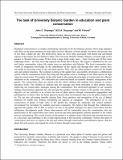| dc.contributor.author | John C Onyango, MOA Onyango, W Freund | |
| dc.date.accessioned | 2020-08-13T11:48:48Z | |
| dc.date.available | 2020-08-13T11:48:48Z | |
| dc.date.issued | 2007 | |
| dc.identifier.uri | https://repository.maseno.ac.ke/handle/123456789/2082 | |
| dc.description.abstract | Biological conservation is a complex undertaking especially in the developing countries where large populace
still relies on the forest products for their daily survival. Majority of these people live below the poverty line
of less than a dollar per day. Hot biodiversity spots are more often associated with humid and sub-humid
regions in the tropics but not limited to them. The University Botanic Garden, Maseno is located right on the
equator in Western Kenya some 20 Km from a large fresh water mass – Lake Victoria and 30 Km from
Kakamega forest – the only surviving tropical rain forest left in Kenya. The region is inhabited by the Luo
and Luhya communities whose life rotates more on agriculture and fisheries. The local communities have
wealth of indigenous knowledge on the ethnobotany of the region and through their taboo system have
succeeded in protecting some of the rare plant species. They also use plant products extensively for health
care and cultural practices. The scientists working at the garden have successfully developed a collaboration
system with the communities where they bring into the garden seeds or seedlings of rare plant species of high
value for conservation. The garden on the other hand is advocating the principles of conservation for efficient
utilization to the community. The collections are conserved based on scientific thematic arrangement at the
garden. The conservation ideas are shared with the school children and students from primary to tertiary
education levels. The children or students take the message and learnt principles to their parents hence
improving our conservation strategies among the communities. The downward approach in our research
findings dissemination approach has also brought the gardens activities closure to the people. The primary
objective of our activities is to reverse the lose of plant species through communities engagement and
polishing for we believe they are better placed to protect their environment, than even the policy makers will
do. We are also advocating benefits sharing from forest products and recognition of the use of herbal
medicine for health care without considering the practice as repugnant. The introduction of ex situ
conservation of plants of high value in the garden has changed the landscape and created aesthetic
environment for recreation by students and local community. We believe that through this collaborative
approach the garden will be able to achieve its role in the global strategies for plant conservation and the
millennium development goals. These achievements will be sustainable since the communities who are
beneficiaries of the conservation have been involved and their participation remains pertinent in the whole
process and planning. The overall mission of the garden is to support study, Education and research activities
at a university and contribute to the overall improvement of the university community. Nurture the spirit of
conservation and strive to improve the life and culture through conservation and utilization power, link the
plants life with society and expand the circle of nature through conservation. | en_US |
| dc.publisher | Botanic Gardens Conservation International | en_US |
| dc.subject | Botanic Garden;education; plant conservation | en_US |
| dc.title | The task of University Botanic Garden in education and plant conservation | en_US |
| dc.type | Article | en_US |

